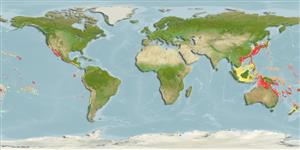Common names from other countries
Environment: milieu / climate zone / depth range / distribution range
Ecology
Marine; reef-associated; depth range 2 - 350 m (Ref. 58302). Tropical
Western Central Pacific: endemic, from Japan, Taiwan, Ogasawara Islands, Hawaii and the Society Islands.
Length at first maturity / Size / Weight / Age
Maturity: Lm ?, range 44 - ? cm
Max length : 91.5 cm SL male/unsexed; (Ref. 54980)
Benthic (Ref. 58302). Occurs in crevices in shallow reefs. Often snatches game from divers. Used as food fish in some districts in Japan.
Life cycle and mating behavior
Maturities | Reproduction | Spawnings | Egg(s) | Fecundities | Larvae
Chen, H.-M., K.-T. Shao and C.T. Chen, 1994. A review of the muraenid eels (Family Muraenidae) from Taiwan with descriptions of twelve new records. Zool. Stud. 33(1):44-64. (Ref. 6934)
IUCN Red List Status (Ref. 130435)
CITES (Ref. 128078)
Not Evaluated
Human uses
Fisheries: minor commercial
Tools
Special reports
Download XML
Internet sources
Estimates based on models
Preferred temperature (Ref.
115969): 14 - 27.7, mean 21.8 (based on 398 cells).
Phylogenetic diversity index (Ref.
82804): PD
50 = 0.5000 [Uniqueness, from 0.5 = low to 2.0 = high].
Bayesian length-weight: a=0.00058 (0.00035 - 0.00094), b=3.28 (3.14 - 3.42), in cm Total Length, based on LWR estimates for this species & Genus-body shape (Ref.
93245).
Trophic level (Ref.
69278): 4.5 ±0.61 se; based on food items.
Resilience (Ref.
120179): Low, minimum population doubling time 4.5 - 14 years (Preliminary K or Fecundity.).
Fishing Vulnerability (Ref.
59153): High to very high vulnerability (67 of 100).
